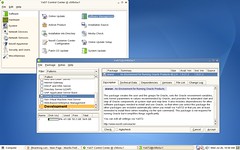I just discovered that cool new function in SQL/Developer
just right click on the table and chose export sql insert
-- INSERTING into EMP
Insert into "EMP" ("EMPNO","ENAME","JOB","MGR",
"HIREDATE","SAL","COMM","DEPTNO") values (7369
,'SMITH','CLERK',7902,to_date('1980-12-17',
'DD-MON-RR'),800,null,20);
Insert into "EMP" ("EMPNO","ENAME","JOB","MGR",
"HIREDATE","SAL","COMM","DEPTNO") values (7499
,'ALLEN','SALESMAN',7698,to_date('1981-02-20',
'DD-MON-RR'),1600,300,30);
Insert into "EMP" ("EMPNO","ENAME","JOB","MGR",
"HIREDATE","SAL","COMM","DEPTNO") values (7521
,'WARD','SALESMAN',7698,to_date('1981-02-22',
'DD-MON-RR'),1250,500,30);
Insert into "EMP" ("EMPNO","ENAME","JOB","MGR",
"HIREDATE","SAL","COMM","DEPTNO") values (7566
,'JONES','MANAGER',7839,to_date('1981-04-02',
'DD-MON-RR'),2975,null,20);
Insert into "EMP" ("EMPNO","ENAME","JOB","MGR",
"HIREDATE","SAL","COMM","DEPTNO") values (7654
,'MARTIN','SALESMAN',7698,to_date('1981-09-28',
'DD-MON-RR'),1250,1400,30);
Insert into "EMP" ("EMPNO","ENAME","JOB","MGR",
"HIREDATE","SAL","COMM","DEPTNO") values (7698
,'BLAKE','MANAGER',7839,to_date('1981-05-01',
'DD-MON-RR'),2850,null,30);
Insert into "EMP" ("EMPNO","ENAME","JOB","MGR",
"HIREDATE","SAL","COMM","DEPTNO") values (7782
,'CLARK','MANAGER',7839,to_date('1981-06-09',
'DD-MON-RR'),2450,null,10);
Insert into "EMP" ("EMPNO","ENAME","JOB","MGR",
"HIREDATE","SAL","COMM","DEPTNO") values (7788
,'SCOTT','ANALYST',7566,to_date('1987-04-19',
'DD-MON-RR'),3000,null,20);
Insert into "EMP" ("EMPNO","ENAME","JOB","MGR",
"HIREDATE","SAL","COMM","DEPTNO") values (7839
,'KING','PRESIDENT',null,to_date('1981-11-17',
'DD-MON-RR'),5000,null,10);
Insert into "EMP" ("EMPNO","ENAME","JOB","MGR",
"HIREDATE","SAL","COMM","DEPTNO") values (7844
,'TURNER','SALESMAN',7698,to_date('1981-09-08',
'DD-MON-RR'),1500,0,30);
Insert into "EMP" ("EMPNO","ENAME","JOB","MGR",
"HIREDATE","SAL","COMM","DEPTNO") values (7876
,'ADAMS','CLERK',7788,to_date('1987-05-23',
'DD-MON-RR'),1100,null,20);
Insert into "EMP" ("EMPNO","ENAME","JOB","MGR",
"HIREDATE","SAL","COMM","DEPTNO") values (7900
,'JAMES','CLERK',7698,to_date('1981-12-03',
'DD-MON-RR'),950,null,30);
Insert into "EMP" ("EMPNO","ENAME","JOB","MGR",
"HIREDATE","SAL","COMM","DEPTNO") values (7902
,'FORD','ANALYST',7566,to_date('1981-12-03',
'DD-MON-RR'),3000,null,20);
Insert into "EMP" ("EMPNO","ENAME","JOB","MGR",
"HIREDATE","SAL","COMM","DEPTNO") values (7934
,'MILLER','CLERK',7782,to_date('1982-01-23',
'DD-MON-RR'),1300,null,10);
It is quite handy to post insert statements on forums, or move a table from one database to another just with copy paste, or export only a subset of the columns, because you can export a view too


